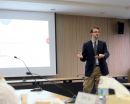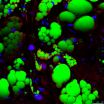INFORMATION:
MCW researchers find link between sleep deprivation and cell damage
2014-12-08
(Press-News.org) Scientists at the Medical College of Wisconsin (MCW) have discovered a link between sleep loss and cell injury. Results of a new study find sleep deprivation causes the damage to cells, especially in the liver, lung, and small intestine. Recovery sleep following deprivation heals the damage.
The findings are published in the December issue of Sleep, a joint publication of the Sleep Research Society and the American Academy of Sleep Medicine. The lead author is Carol Everson, Ph.D., professor of neurology, cell biology, neurobiology and anatomy at MCW. Co-authors are Christopher Henchen, B.S., Clinical Research Coordinator at MCW; Aniko Szabo Ph.D., associate professor of biostatistics and director of the Biostatistics Consulting Service at MCW; and Neil Hogg, Ph.D., professor of biophysics and assistant dean of recruitment for MCW's Graduate School of Biomedical Sciences.
Dr. Everson's team discovered that sleep loss causes cell damage, resulting in a link between sleep and disease risk. Furthermore, recovery sleep from sleep loss was found to restore the balance and decrease cell injury. These findings elucidate previous research indicating sleep abnormalities as risk factors for diseases such as cardiovascular disease and cancer.
"The study culminates years of work and provides physical evidence that sleep deprivation injures cells and that sleep recovery restores the balance between, among other parameters, DNA damage and repair," Dr. Everson said. "This is important because specific physical underpinnings that pose disease risk from sleep deficiency have been elusive and are now becoming identified."
ELSE PRESS RELEASES FROM THIS DATE:
Public servants are individually motivated to help environment
2014-12-08
Athens, Ga. - New University of Georgia research shows that while on the job, public servants contribute not just to mandated sustainability but also to discretionary eco-friendly initiatives of their own.
"Some people are born with a higher intrinsic need to serve the public," said study co-author Robert K. Christensen, an associate professor in the School of Public and International Affairs. "They have a desire to help others and serve society. Government and nonprofit managers, for example, typically have higher levels of public service motivation than business managers."
The ...
Toughest breast cancer may have met its match
2014-12-08
Triple-negative breast cancer is as bad as it sounds. The cells that form these tumors lack three proteins that would make the cancer respond to powerful, customized treatments. Instead, doctors are left with treating these patients with traditional chemotherapy drugs that only show long-term effectiveness in 20 percent of women with triple-negative breast cancer. Now, researchers at The Johns Hopkins University have discovered a way that breast cancer cells are able to resist the effects of chemotherapy -- and they have found a way to reverse that process.
A report of ...
UH Case Medical Center experts present data at ASH Annual Meeting
2014-12-08
CLEVELAND: Researchers from Seidman Cancer Center at University Hospitals (UH) Case Medical Center and Case Western Reserve University School of Medicine presented new research findings this weekend at the 56th Annual Meeting of the American Society of Hematology (ASH) in San Francisco.
In a poster presentation (Abstract #4053), Jane Little, MD, and colleagues presented promising findings related to a novel biochip aimed at improving outcomes for patients with sickle cell disease. Although it is well-known that red cell interactions are important in sickle cell disease, ...
NOAA: Researchers offer new insights into predicting future droughts in California
2014-12-08
According to a new NOAA-sponsored study, natural oceanic and atmospheric patterns are the primary drivers behind California's ongoing drought. A high pressure ridge off the West Coast (typical of historic droughts) prevailed for three winters, blocking important wet season storms, with ocean surface temperature patterns making such a ridge much more likely. Typically, the winter season in California provides the state with a majority of its annual snow and rainfall that replenish water supplies for communities and ecosystems.
Further studies on these oceanic conditions ...
World record for compact particle accelerator
2014-12-08
Using one of the most powerful lasers in the world, researchers have accelerated subatomic particles to the highest energies ever recorded from a compact accelerator.
The team, from the U.S. Department of Energy's Lawrence Berkeley National Lab (Berkeley Lab), used a specialized petawatt laser and a charged-particle gas called plasma to get the particles up to speed. The setup is known as a laser-plasma accelerator, an emerging class of particle accelerators that physicists believe can shrink traditional, miles-long accelerators to machines that can fit on a table.
The ...
Punishing kids for lying just doesn't work
2014-12-08
If you want your child to tell the truth, it's best not to threaten to punish them if they lie. That's what researchers discovered through a simple experiment involving 372 children between the ages of 4 and 8.
How the Experiment was Done
The researchers, led by Prof. Victoria Talwar of McGill's Dept. of Educational and Counselling Psychology, left each child alone in a room for 1 minute with a toy behind them on a table, having told the child not to peek during their absence.
While they were out of the room, a hidden video camera filmed what went on.
When the ...
Re-thinking Southern California earthquake scenarios in Coachella Valley, San Andreas Fault
2014-12-08
AMHERST, Mass. - New three-dimensional (3D) numerical modeling that captures far more geometric complexity of an active fault segment in southern California than any other, suggests that the overall earthquake hazard for towns on the west side of the Coachella Valley such as Palm Springs and Palm Desert may be slightly lower than previously believed.
New simulations of deformation on three alternative fault configurations for the Coachella Valley segment of the San Andreas Fault conducted by geoscientists Michele Cooke and Laura Fattaruso of the University of Massachusetts ...
Researchers identify hormone that reduces calorie burning, contributes to obesity
2014-12-08
Hamilton, ON (Dec. 8, 2014) - Researchers from McMaster University have identified an important hormone that is elevated in obese people and contributes to obesity and diabetes by inhibiting brown fat activity.
Brown adipose tissue, widely known as brown fat, is located around the collarbone and acts as the body's furnace to burn calories. It also keeps the body warm. Obese people have less of it, and its activity is decreased with age. Until now, researchers haven't understood why.
There are two types of serotonin. Most people are familiar with the first type in the ...
Rule of 3: Hormone triplet offers hope for obesity and diabetes
2014-12-08
Recently, the researchers had constructed several single molecules with dual hormone action. Now, for the first time, the researchers succeeded in designing a substance that combines three metabolically active hormone components (GLP-1, GIP and glucagon) and offers unmatched potency to fight metabolic diseases in pre-clinical trials.
The team headed by physician scientist Matthias Tschöp (Helmholtz Diabetes Center at HMGU and Metabolic Diseases Chair at TUM) and peptide chemist Richard DiMarchi (Indiana University) has been cooperating for almost a decade to invent ...
A pill for obesity?
2014-12-08
Harvard Stem Cell Institute researchers at Harvard and Massachusetts General Hospital have taken what they are describing as "the first step toward a pill that can replace the treadmill" for the control of obesity - though it of course would not provide all the additional benefits of exercise.
Chad Cowan, an HSCI Principal Faculty Member and his HSCI team report that they have created a system using human stem cells to screen for compounds that have the potential to turn white, or 'bad', fat cells into brown, or 'good' fat cells, and have already identified two compounds ...




